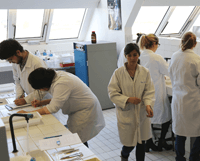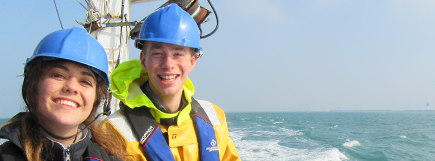Hydrographic Surveying
Code UE : HBB360
- Cours + travaux pratiques
- 6 crédits
- Volume horaire de référence
(+ ou - 10%) : 50 heures
Responsable(s)
Claire MARION
Objectifs pédagogiques
Module Outline:
the main objective of this course is to provide advanced insight into positioning at sea, depth measurements and seabed modelling, and deepening an understanding of the sources of errors and the accuracy that can be achieved with various devices and methods.
Contents
Planimetric Positioning
1. Classification of positioning systems and project types
2. Working principles of planimetric positioning systems
4. Characteristics of radio waves
4. Principles of terrestrial radio positioning systems
5. Principles of acoustic planimetric positioning systems
6. Geometric quality of positioning
Bathymetric Surveys
1. Types of bathymetric sensors SBE, MBE, side-scan
2. Bathymetric equipment: working principles
4. Calibration of Equipment
4. Bathymetric Project Management
the main objective of this course is to provide advanced insight into positioning at sea, depth measurements and seabed modelling, and deepening an understanding of the sources of errors and the accuracy that can be achieved with various devices and methods.
Contents
Planimetric Positioning
1. Classification of positioning systems and project types
2. Working principles of planimetric positioning systems
4. Characteristics of radio waves
4. Principles of terrestrial radio positioning systems
5. Principles of acoustic planimetric positioning systems
6. Geometric quality of positioning
Bathymetric Surveys
1. Types of bathymetric sensors SBE, MBE, side-scan
2. Bathymetric equipment: working principles
4. Calibration of Equipment
4. Bathymetric Project Management
Compétences visées
Learning Outcomes:
1 To clearly and scientifically explain the operation of acoustic, optical and radio positioning systems and bathymetric sensors.
2 To be able to distinguish and estimate the sources of error of acoustic, optical and radio positioning systems.
4 Being able to draw up, apply and evaluate error models for the planimetric or bathymetric measurement values.
4 Being able to predict the expected accuracy with certain equipment and a certain methodology.
5 Being able to draw up digital seabed models and to be able to assess them qualitatively.
6 Being able to prepare a motivated scientific report about a bathymetric measurement or processing.
1 To clearly and scientifically explain the operation of acoustic, optical and radio positioning systems and bathymetric sensors.
2 To be able to distinguish and estimate the sources of error of acoustic, optical and radio positioning systems.
4 Being able to draw up, apply and evaluate error models for the planimetric or bathymetric measurement values.
4 Being able to predict the expected accuracy with certain equipment and a certain methodology.
5 Being able to draw up digital seabed models and to be able to assess them qualitatively.
6 Being able to prepare a motivated scientific report about a bathymetric measurement or processing.
Contenu
I. Planimetric Positioning
Lecture 1
Types of Projects (survey companies projects versus safety of navigation)
Types of Survey projects (capital dredging, maintenance dredging, reclamation, beach nourishment, mining, environmental,…)
Classification of Positioning Systems (historically, acoustic versus optical versus electromagnetic waves, targeted users,…)
Lecture 2 Working principles of planimetric positioning systems
Horizontal positioning fundamentals
- Horizontal control surveys
- Horizontal positioning procedures (e.g. intersection, resection, polar and traverse)
- Appropriate instruments
Distance measurements
- Principles of stadia, microwave, infrared and laser systems, as used for measuring distances and distance LOPs. Distance measurement equipment
Electromagnetic positioning
- Principles of pulsed, differencing (phase and time) and range and bearing systems
Optical positioning: bearing-based (intersection), angle-based (resection), bearing/distance based (polar method)
Angular measurements
- Principles of sextants and theodolites as used for horizontal positioning
- Use sextants and theodolites and evaluate errors
Test 1 On lectures 1 and 2
Lecture 3 Global Navigation Satellite Positioning Systems
satellite systems
- Different satellite positioning systems and for each, their role (primary positioning system or overlay) and orbit geometry (e.g. inclination, ellipticity, altitude)
- Satellite observables
- Satellite coverage and availability
- GNSS concept and principles
- Characteristics of various public and private DGNSS services (single baseline, network, state space)
- Pseudoranging and carrier phase based modes of satellite positioning
- Performance of code vs. carrier; differential vs. autonomous modes; dual vs. single frequency; fixed vs. float ambiguity resolution. Operate GNSS and DGNSS equipment
Lecture 4 Remote Sensing
Multispectral imagery, water penetration and reflectance
Satellite derived bathymetry (DB)
Spatial resolution and accuracy
Geometrical properties of satellite images and aerial photographs.
Test 2 On lectures 3 and 4
Lecture 5 Characteristics of Acoustic waves and principles of acoustic planimetric positioning systems.
UNDERWATER ACOUSTICS
Acoustic fundamentals
- Plane and spherical waves
- Sound speed and particle velocity
- Active Sonar Equation
- Acoustic units
- Intensities
- Sound levels
Generation of Acoustic Waves
- How acoustic waves are generated
- Source level, frequency, wavelength, amplitude,
- Pulse duration (pulse length), and pulse repetition
Transmission of Acoustic Waves
- Causes of propagation loss
- Differences in water properties that affect propagation loss
Acoustic positioning concepts
- Principles of long, short and supershort baseline acoustic positioning system modes. The deployment and calibration, signal structure, sources of error, and expected uncertainties for each mode
ROV
- types
-use of the camera, diver and ROV in the inspection of sea floor contacts
Lecture 6 Geometric quality of positioning
Sources of errors
- Sources and magnitudes of errors for each positioning method and system
- Problems due to multipath, interference, reradiation, geometry, time-sharing, and power supplies
Performance of each system to be used
- Monitoring of system performance by analyzing results of least squares adjustments of measurements, where appropriate
- Repeatability, relative and absolute accuracy
Test 4 On lectures 5 and 6
II. Bathymetric Surveys
Lecture 7 Types of bathymetric sensors: SBE, MBE, side-scan: advantages and drawbacks.
single beam echo sounders
- Narrow beam and wide beam transducers
- The transducer characteristics that affect beam width
- The piezoelectric principle and its application to transducers
- The arrangement of single element and multielement array transducers
- The methods of mounting transducers: hull, towed, over the side, and boom
Multi beam
- The principles and geometry of multi beam echo sounding
- The combination of transducer elements into transmit and receive arrays
- The basic principles of multi beam sonar transmit and receive beam forming and beam steering
side scan systems
- The effect on side scan sonar performance (range, resolution, target detection) of frequency, beam angle, range scale, gain, towing speed, towing height, and deployment (deep tow, shallow tow, pole mount)
- The set up, deployment and operation of a side scan sonar, for specific applications
- Using available software tools, plot and position sonar contacts and create side scan mosaics
- The determination of height and size of obstructions from sonar records
- The sources of side scan image distortion
- Sonar signatures of such items as debris from wrecks, pipelines, gas, fish and fresh water
Lecture 8 Aerial Bathymetric LIDAR versus terrestrial LIDAR.
NON-ACOUSTIC BATHYMETRIC TECHNIQUES
Laser bathymetry
- The principles, capabilities, and limitations of bathymetric lidar
- Environmental and operational environments in which bathymetric lidar surveys are complementary to echo sounder surveys
- a Secchi Depth and list which environmental factors affect it
Remote sensing bathymetry
- The techniques of passive remote sensing for bathymetry
- Other airborne, shore-based, and satellite active remote sensing techniques for bathymetry
Inertial navigation
Test 4 On lectures 7 and 8
Lecture 9 Working principles of acoustic bathymetric equipment.
Sound Speed and Refraction
- Effects of the physical properties of water on sound speed
- Calculation of sound speed from temperature, pressure, and salinity
- Using software tools, create a sound speed with the profile of the water column
- Effects of variation of sound speed in the water column on the path of sound rays
Reflection and Scattering of Acoustic Waves
- Characteristics of the seafloor that affect the reflection of acoustic waves
Acoustic Noise and the Directivity Index
- The sources of noise in the environment
- The effect of noise on echo sounding
- The directivity index
Reception of Acoustic Waves and System Performance
- Beam width, bandwidth, gain, detection threshold
- Range resolution and spatial resolution
Acoustic Devices
- The purpose and operation of acoustic devices such as: transponders pingers, acoustic releases, and sound speed meters. Operate such acoustic devices
PHASE DIFFERENCING BATHYMETRY (INTERFEROMETRY)
Phase Differencing Systems
- The principles and geometry of interferometry
- Phase differencing bathymetric sonars
- Arrangement of transducer arrays
Deployment and mounting
- Options for deployment and mounting of phase differencing systems
Lecture 10 Calibration of bathymetric vessels
- Definition of the "patch test": Roll, Pitch, Yaw determination methods.
-
Modalité d'évaluation
Evaluation
Evaluation form:
Periodic evaluation and continuous assessment using 5 multiple-choice computer tests
Examination methods in case of periodic evaluation during the first examination period
Written examination with oral defense. Presentation and written assignment.
Examination methods in case of periodic evaluation during the second examination period
Written examination with oral defense. Presentation and written assignment.
Assessment methodology: Calculation of the examination mark:
1/2 on the theoretical exam, 1/6 on the 5 tests, 1/6 on the presentation and 1/6 on the assignment
Assessment criteria
In addition to general overview questions, the exam also asks more specific detailed questions that gauge the depth of knowledge, the ability to make connections, the insight to distinguish main issues from side issues, and the ability to formulate a scientifically precise and clear answer. , also to questions that expect a transposition of knowledge to areas of untreated applications. Students are also expected to have one or two presentations on a mutually agreed hydrographic topic.
Evaluation form:
Periodic evaluation and continuous assessment using 5 multiple-choice computer tests
Examination methods in case of periodic evaluation during the first examination period
Written examination with oral defense. Presentation and written assignment.
Examination methods in case of periodic evaluation during the second examination period
Written examination with oral defense. Presentation and written assignment.
Assessment methodology: Calculation of the examination mark:
1/2 on the theoretical exam, 1/6 on the 5 tests, 1/6 on the presentation and 1/6 on the assignment
Assessment criteria
In addition to general overview questions, the exam also asks more specific detailed questions that gauge the depth of knowledge, the ability to make connections, the insight to distinguish main issues from side issues, and the ability to formulate a scientifically precise and clear answer. , also to questions that expect a transposition of knowledge to areas of untreated applications. Students are also expected to have one or two presentations on a mutually agreed hydrographic topic.
Cette UE apparaît dans les diplômes et certificats suivants
Rechercher une formation
CRITERES
- Le champ Mot-clé permet de rechercher les formations grâce à un mot ou à une expression présent dans l’intitulé ou dans les index d’une formation.
Des index vous sont suggérés à partir du 3e caractère saisi, mais vous pouvez aussi saisir librement tout autre chaîne de caractères . - les différents items sélectionnés sont croisés.
ex: "Comptabilité" et "Région Alsace"
CODE
- Vous pouvez utiliser le caractère joker * pour remplacer un nombre quelconque de caractères
- UE : le code comprend 3 lettres immédiatement suivies de 3 chiffres
- Certificat : le code comprend 2 ou 3 lettres immédiatement suivies de 3 chiffres. Certains certificats se déclinent selon plusieurs parcours :
- pour afficher le tronc commun, tapez le code simple (ex : LG005).
- pour afficher un parcours précis dans un diplôme, faites suivre le code de la lettre "p", et du numéro de parcours (ex : LG005p2). Si le diplôme ne comporte qu'un seul parcours, faites suivre la lettre "p" de -1 (ex : CYC17p-1).
Dans tous les cas, veillez à ne pas insérer d'espace ou de ponctuation supplémentaire.
Chargement du résultat...

Intitulé de la formation |
Type |
Modalité(s) |
Lieu(x) |
|
|---|---|---|---|---|
Intitulé de la formation
Bachelor océanographe prospecteur
|
Lieu(x)
Initial
|
Lieu(x)
Normandie, Paris
|
||
| Intitulé de la formation | Type | Modalité(s) | Lieu(x) |
Contact
Voir le calendrier, le tarif, les conditions d'accessibilité et les modalités d'inscription dans le(s) centre(s) d'enseignement qui propose(nt) cette formation.
Enseignement non encore programmé
Code UE : HBB360
- Cours + travaux pratiques
- 6 crédits
- Volume horaire de référence
(+ ou - 10%) : 50 heures
Responsable(s)
Claire MARION











